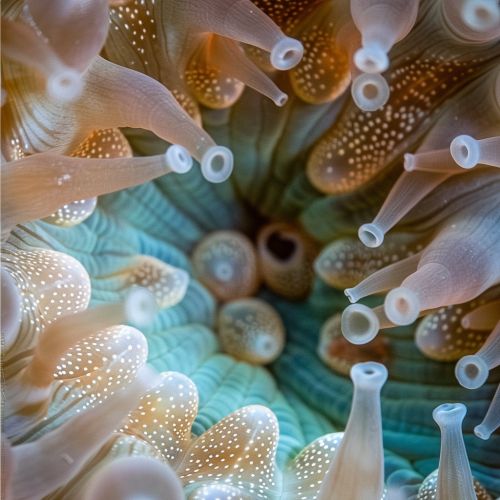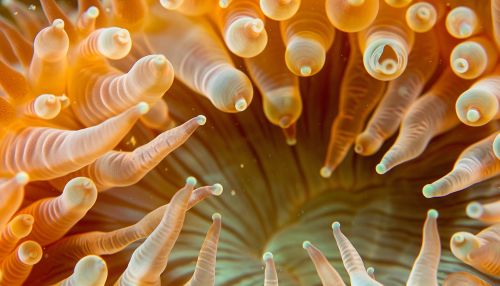Nematocyst
Introduction
A nematocyst is a specialized subcellular structure found in the cnidocytes of cnidarians, such as jellyfish, sea anemones, and corals. These organelles are known for their role in prey capture and defense mechanisms. Nematocysts are one of the defining characteristics of the phylum Cnidaria and are highly specialized for their function. They are capable of delivering a sting that can immobilize prey or deter predators.
Structure
Nematocysts are complex organelles that consist of a capsule, a coiled tubule, and a trigger mechanism. The capsule is composed of a tough, elastic material that can withstand high internal pressures. Inside the capsule, the tubule is coiled and contains toxins. The trigger mechanism, known as the cnidocil, is a hair-like structure that, when stimulated, causes the nematocyst to discharge.


Capsule
The capsule is the main body of the nematocyst and is composed of a chitin-like substance. It is highly elastic and can store a significant amount of potential energy. The internal pressure within the capsule can reach up to 150 atmospheres, making it one of the most pressurized biological structures known.
Tubule
The tubule is a long, hollow thread that is coiled inside the capsule. It is often barbed or spined, which helps it anchor into the prey or predator upon discharge. The tubule contains a variety of toxins, enzymes, and other bioactive compounds that can cause paralysis, pain, or even death in the target organism.
Cnidocil
The cnidocil is a sensory structure that acts as a trigger for the nematocyst. It is sensitive to mechanical and chemical stimuli. When the cnidocil is stimulated, it causes a rapid influx of calcium ions into the capsule, leading to the explosive discharge of the tubule.
Function
Nematocysts serve multiple functions, primarily related to prey capture and defense. They are highly effective at immobilizing prey, allowing the cnidarian to consume it at leisure. Additionally, nematocysts can deter predators through the delivery of painful or toxic stings.
Prey Capture
The primary function of nematocysts is to capture prey. When a prey organism comes into contact with the cnidocil, the nematocyst discharges, embedding the tubule into the prey and injecting toxins. This can cause immediate paralysis or death, making it easier for the cnidarian to ingest the prey.
Defense
Nematocysts also play a crucial role in defense. They can deter predators by delivering painful stings. Some species of cnidarians have nematocysts that can cause severe pain or even be lethal to potential predators, providing an effective means of protection.
Types of Nematocysts
There are several types of nematocysts, each specialized for different functions. The main types include:
Penetrant Nematocysts
Penetrant nematocysts, also known as stenoteles, are designed to penetrate the skin of prey or predators. They have barbed tubules that anchor into the target, allowing the toxins to be delivered effectively.
Glutinant Nematocysts
Glutinant nematocysts, or desmonemes, are adhesive in nature. They are used to entangle and immobilize prey by sticking to their surface.
Volvent Nematocysts
Volvent nematocysts, also known as spironemes, have a coiled tubule that wraps around the prey. This type of nematocyst is more common in sea anemones and is used to ensnare prey.
Toxins
The toxins contained within nematocysts are diverse and can have various effects on the target organism. These toxins include neurotoxins, cytolysins, and proteolytic enzymes.
Neurotoxins
Neurotoxins affect the nervous system of the prey, causing paralysis or death. These toxins can interfere with nerve signal transmission, leading to the immobilization of the prey.
Cytolysins
Cytolysins are toxins that cause cell lysis, leading to tissue damage. They can break down cell membranes, causing the contents of the cells to leak out and resulting in cell death.
Proteolytic Enzymes
Proteolytic enzymes break down proteins, aiding in the digestion of the prey. These enzymes can also cause tissue damage and contribute to the overall effectiveness of the nematocyst's sting.
Evolutionary Significance
Nematocysts are a key evolutionary adaptation that has allowed cnidarians to become successful predators. Their development has provided these organisms with an effective means of capturing prey and defending against predators.
Origin
The origin of nematocysts is a subject of ongoing research. It is believed that they evolved from simpler cellular structures that were capable of delivering toxins. Over time, these structures became more specialized and complex, leading to the highly efficient nematocysts seen in modern cnidarians.
Diversification
The diversification of nematocysts has allowed cnidarians to exploit a wide range of ecological niches. Different types of nematocysts have evolved to target specific prey or to provide defense against particular predators, contributing to the ecological success of the phylum.
Ecological Impact
Nematocysts play a significant role in marine ecosystems. They influence predator-prey interactions and contribute to the population dynamics of various marine species.
Predator-Prey Interactions
Nematocysts are a crucial factor in the predator-prey interactions involving cnidarians. They enable cnidarians to capture a wide variety of prey, including fish, plankton, and other invertebrates. This predatory behavior can have cascading effects on the marine food web.
Population Control
By preying on various marine organisms, cnidarians help control the populations of these species. This can prevent overpopulation and maintain ecological balance within marine ecosystems.
Human Interaction
Nematocysts can have significant effects on humans, particularly in the context of jellyfish stings. These stings can range from mild irritation to severe pain and, in some cases, can be life-threatening.
Jellyfish Stings
Jellyfish stings are a common occurrence in coastal areas and can cause a range of symptoms. The severity of the sting depends on the species of jellyfish and the type of nematocysts involved.
Medical Applications
Research into nematocysts and their toxins has potential medical applications. The bioactive compounds found in nematocysts could be used in developing new painkillers, anti-cancer drugs, and other therapeutic agents.
Conclusion
Nematocysts are highly specialized organelles that play a crucial role in the survival and ecological success of cnidarians. Their complex structure and potent toxins make them effective tools for prey capture and defense. Understanding the biology and function of nematocysts provides valuable insights into the evolutionary adaptations of cnidarians and their impact on marine ecosystems.
